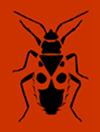RNA interference-based characterization of Caspar, DREDD and FADD genes in immune signaling pathways of the red flour beetle, Tribolium castaneum (Coleoptera: Tenebrionidae)
IF 1.2
3区 农林科学
Q2 Agricultural and Biological Sciences
引用次数: 6
Abstract
We previously demonstrated that two immune signaling pathways, Toll and IMD, were concomitantly activated in the model beetle Tribolium castaneum by challenges to their immune system by several species of microbes, including Gram-positive and -negative bacteria as well as yeast. This contrasts with the Drosophila immune system in which more specifi c pathway activation depending on the type of microbe is well established. We suggest that the activation of an indiscriminate immune pathway in T. castaneum is due in part to an unselective recognition of pathogen-associated molecular patterns by the extracellular sensing modules of the two pathways. In order to obtain a more detailed understanding of the T. castaneum immune pathway, we investigated whether potential components of the T. castaneum IMD pathway, Caspar, DREDD and FADD, are involved in immune reactions triggered by microbial challenges. A sequence analysis of these three genes with the orthologues of other species, including insects, mouse and human, indicated that T. castaneum Caspar, DREDD and FADD functioned as immune signal transducers, which are usually induced by microbial challenges. However, these genes were not induced by microbial challenges. To establish whether these genes are involved in immune reactions, we used RNA interference-mediated knockdown of these genes to assess the microbial induction levels of the representative read-out antimicrobial peptide genes of the respective classes. The results indicated that these genes encode the canonical constituents of the IMD pathway of this beetle. DREDD and FADD infl uenced the induction of Toll-dependent antimicrobial peptide genes, providing novel crosstalk points between the two immune pathways, which appears to support indiscriminate pathway activation in T. castaneum. Furthermore, the phenotypes of DREDD or FADD knockdown pupae challenged by the two model bacterial pathogens correlated with AMP gene induction in the respective knockdowns, indicating that these intracellular factors contributed to antibacterial host defenses. * These authors equally contributed. INTRODUCTION The insect immune system is solely composed of innate immune reactions that utilize germ line-encoded receptors to detect the invasion of several distinct pathogens (Hultmark, 2003; Ferrandon et al., 2007; Lemaitre & Hoffmann, 2007). When recognized, invading pathogens are attacked by a battery of innate immune responses. Insect immune responses as well as vertebrate immune responses may be conveniently divided into cellular and humoral immunities, the latter of which involves the systemic and robust production of antimicrobial peptides (AMPs) as a major and well-characterized response. Intensive studies on the model organism Drosophila melanogaster (Meigen) over the past two decades have delineated the paths and facEur. J. Entomol. 119: 23–35, 2022 doi: 10.14411/eje.2022.003基于RNA干扰的赤谷三棱红粉甲虫免疫信号通路中Caspar、DREDD和FADD基因的表征(鞘翅目:Tenebrionidae)
我们之前证明了两种免疫信号通路Toll和IMD在几种微生物(包括革兰氏阳性和阴性细菌以及酵母)对模型甲虫免疫系统的挑战下同时被激活。这与果蝇的免疫系统形成了对比,果蝇的免疫系统中更具体的途径激活取决于微生物的类型。我们认为,castaneum中任意免疫途径的激活部分是由于这两种途径的细胞外传感模块对病原体相关分子模式的非选择性识别。为了更详细地了解castaneum免疫通路,我们研究了castaneum IMD通路的潜在组分Caspar、DREDD和FADD是否参与微生物挑战引发的免疫反应。将这3个基因与昆虫、小鼠和人类等其他物种的同源基因进行序列分析,结果表明,castaneum Caspar、DREDD和FADD是由微生物攻击诱导的免疫信号转导基因。然而,这些基因不是由微生物挑战诱导的。为了确定这些基因是否参与免疫反应,我们使用RNA干扰介导的敲低这些基因来评估各自类别中具有代表性的读出抗菌肽基因的微生物诱导水平。结果表明,这些基因编码了这种甲虫的IMD途径的典型成分。DREDD和FADD影响toll依赖性抗菌肽基因的诱导,在两种免疫途径之间提供了新的串扰点,这似乎支持castaneum中不加区分的途径激活。此外,两种模式细菌病原体挑战的DREDD或FADD敲低蛹的表型与各自敲低中AMP基因的诱导相关,表明这些细胞内因子有助于抗菌宿主防御。这些作者贡献相同。昆虫的免疫系统完全由先天免疫反应组成,利用种系编码的受体来检测几种不同病原体的入侵(Hultmark, 2003;Ferrandon et al., 2007;Lemaitre & Hoffmann, 2007)。一旦被识别,入侵的病原体就会受到一系列先天免疫反应的攻击。昆虫的免疫反应和脊椎动物的免疫反应可以方便地分为细胞免疫和体液免疫,后者涉及到抗菌肽(AMPs)的系统和强大的生产作为一个主要的和充分表征的反应。在过去的二十年里,对模式生物黑腹果蝇(Drosophila melanogaster, Meigen)的深入研究已经描绘了其路径和特征。[j] .中国生物医学工程学报,2016,33 (2):444 - 444
本文章由计算机程序翻译,如有差异,请以英文原文为准。
求助全文
约1分钟内获得全文
求助全文
来源期刊
CiteScore
2.30
自引率
7.70%
发文量
43
审稿时长
6-12 weeks
期刊介绍:
EJE publishes original articles, reviews and points of view on all aspects of entomology. There are no restrictions on geographic region or taxon (Myriapoda, Chelicerata and terrestrial Crustacea included). Comprehensive studies and comparative/experimental approaches are preferred and the following types of manuscripts will usually be declined:
- Descriptive alpha-taxonomic studies unless the paper is markedly comprehensive/revisional taxonomically or regionally, and/or significantly improves our knowledge of comparative morphology, relationships or biogeography of the higher taxon concerned;
- Other purely or predominantly descriptive or enumerative papers [such as (ultra)structural and functional details, life tables, host records, distributional records and faunistic surveys, compiled checklists, etc.] unless they are exceptionally comprehensive or concern data or taxa of particular entomological (e.g., phylogenetic) interest;
- Papers evaluating the effect of chemicals (including pesticides, plant extracts, attractants or repellents, etc.), irradiation, pathogens, or dealing with other data of predominantly agro-economic impact without general entomological relevance.

 求助内容:
求助内容: 应助结果提醒方式:
应助结果提醒方式:


